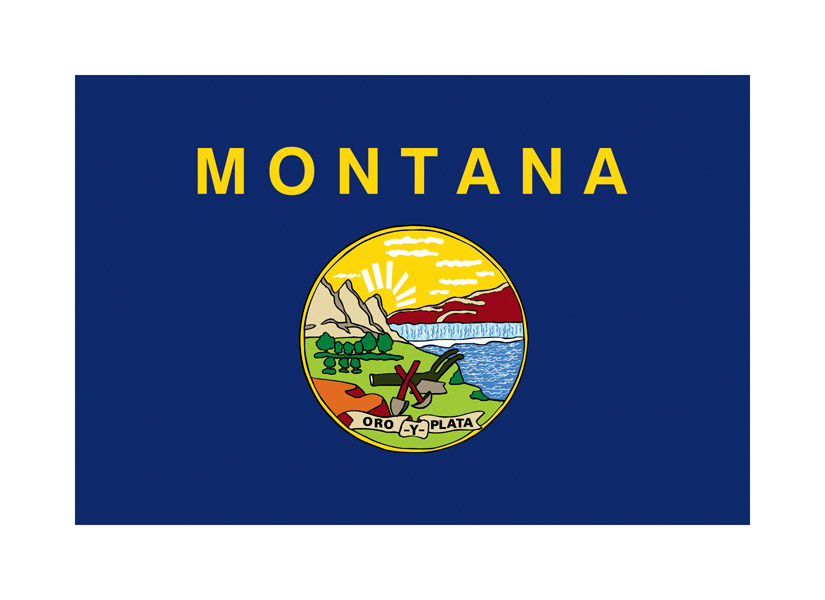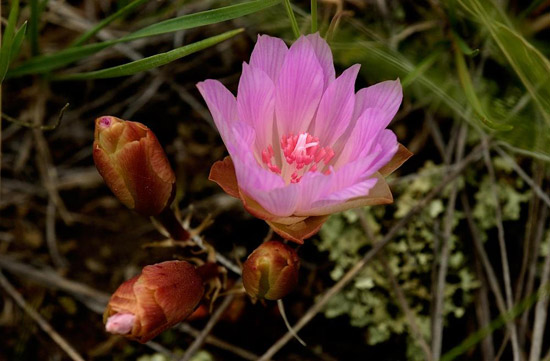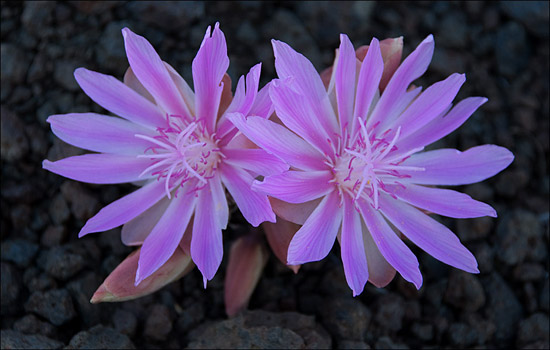Bitterroot (common name)
Lewisia rediviva (scientific name)
Overview
In 1893 the state of Montana sent bitterroot to the World's Columbian Exposition, and it became the official state flower in 1895. Low-growing bitterroot prefers cool weather. The open, cup-shaped flowers range from white to pink with up to 18 narrow petals, six to eight sepals, and multiple stamens. Each petal is about an inch long, and each flower grows on a short stem. The leaves are succulent and grow directly out of the ground in a rosette formation, usually dying back as the plant comes into bloom.
The stems are also short, about an inch longer than the leaves, and each produces one flower. The flowers appear in late spring or early summer, closing at night and reopening with the morning sun. The seed vessel is a capsule, 0.2 inches (5–6 millimeters) long that holds dark, shiny seeds. The plant is very drought-tolerant and can survive for more than a year without water. It is distributed from southern British Columbia east to Montana and south to southern California and northern Arizona. This perennial herbaceous plant grows mostly on foothill slopes or mountain valleys.
Close-up
Status
Official
Physical Details
Duration: Perennial
Plant: Very low-growing succulent leaves with single flowers on very short stems
Mature Height: 2–4 inches (5–10 centimeters)
Flowering: May through June
Flowers: 1.5–2.75 in (3.6–7 cm) across, with nine to 18 narrow, oblong petals
Flower Color: white to deep pink
Leaves: 1–3 in (2.5–7.5 cm) long, narrow, succulent
Fruit/Seed Color: Dark brown
Habitat
Location: Well-drained, rocky or gravelly foothills 200–9,800 feet (60 to 3,000 meters)
Range: British Columbia to southern California, east to the Cascade Mountains, Colorado, and Arizona.
Trivia
- In spite of the root’s bitter flavor, it is edible boiled and was sometimes a food source for Native Americans. Meriwether Lewis of the Lewis and Clark expedition declared it too bitter to eat. Bitterroot was part of the collection of plant specimens he gave to President Jefferson.
- The Bitterroot Mountains, River, and Valley are all named for this plant.
| Classification | |
|---|---|
| Kingdom: | Plantae |
| Subkingdom: | Tracheobionta |
| Superdivision: | Spermatophyta |
| Division: | Magnoliophyta |
| Class: | Magnoliopsida |
| Subclass: | Caryophyllidae |
| Order: | Caryophyllales |
| Family: | Portulacaceae |
| Genus: | Lewisia |
| Species: | L. rediviva |
Copyright © 1993-2025 World Trade Press. All rights reserved.





